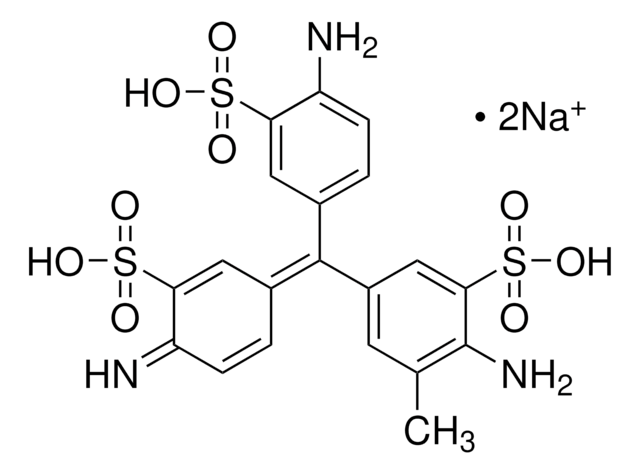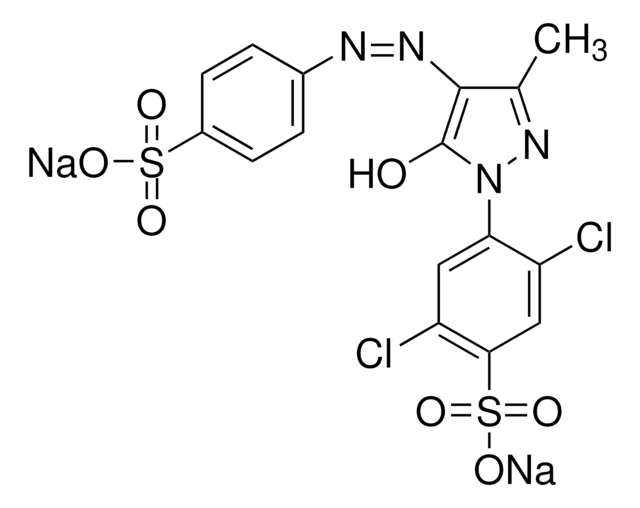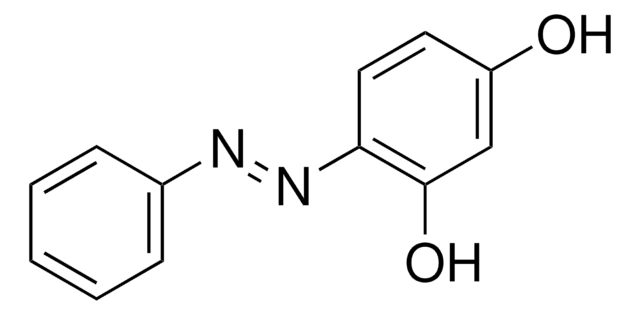861286
Orange G
certified by the BSC, Dye content 80 %
Sinonimo/i:
1-Phenylazo-2-naphthol-6,8-disulfonic acid disodium salt, 7-Hydroxy-8-phenylazo-1,3-naphthalenedisulfonic acid disodium salt, Acid Orange 10, Wool Orange 2G
About This Item
Prodotti consigliati
agenzia
certified by the BSC
Livello qualitativo
Stato
powder
Composizione
Dye content, 80%
tecniche
microbe id | staining: suitable
Colore
orange to very dark orange, and Red to Very Dark Red and Orange-Red and Red-Orange and Dark Red-Orange
Solubilità
H2O: 1 mg/mL
λmax
475 nm
ε (coefficiente d’estinzione)
≥10000 at 329-331 nm in H2O
≥17000 at 473-479 nm in H2O
≥20500 at 246-250 nm in H2O
applicazioni
diagnostic assay manufacturing
hematology
histology
Temperatura di conservazione
room temp
Stringa SMILE
[Na+].[Na+].Oc1ccc2cc(cc(c2c1\N=N\c3ccccc3)S([O-])(=O)=O)S([O-])(=O)=O
InChI
1S/C16H12N2O7S2.2Na/c19-13-7-6-10-8-12(26(20,21)22)9-14(27(23,24)25)15(10)16(13)18-17-11-4-2-1-3-5-11;;/h1-9,19H,(H,20,21,22)(H,23,24,25);;/q;2*+1/p-2/b18-17+;;
HSXUHWZMNJHFRV-QIKYXUGXSA-L
Cerchi prodotti simili? Visita Guida al confronto tra prodotti
Categorie correlate
Applicazioni
Azioni biochim/fisiol
Codice della classe di stoccaggio
11 - Combustible Solids
Classe di pericolosità dell'acqua (WGK)
WGK 3
Punto d’infiammabilità (°F)
Not applicable
Punto d’infiammabilità (°C)
Not applicable
Dispositivi di protezione individuale
Eyeshields, Gloves, type N95 (US)
Scegli una delle versioni più recenti:
Possiedi già questo prodotto?
I documenti relativi ai prodotti acquistati recentemente sono disponibili nell’Archivio dei documenti.
I clienti hanno visto anche
Il team dei nostri ricercatori vanta grande esperienza in tutte le aree della ricerca quali Life Science, scienza dei materiali, sintesi chimica, cromatografia, discipline analitiche, ecc..
Contatta l'Assistenza Tecnica.








